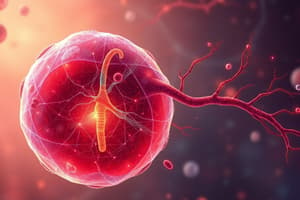Podcast
Questions and Answers
What is the main product of aerobic cellular respiration along with thermal energy?
What is the main product of aerobic cellular respiration along with thermal energy?
- Carbon Dioxide (correct)
- Water (correct)
- Glucose
- Oxygen
Why do larger, multicellular animals require special organ systems for gas exchange?
Why do larger, multicellular animals require special organ systems for gas exchange?
- All cells are in direct contact with the environment.
- Most cells do not directly contact the external environment. (correct)
- They can rely solely on diffusion for oxygen supply.
- They generate energy exclusively from anaerobic respiration.
Which process describes the diffusion of oxygen into body cells?
Which process describes the diffusion of oxygen into body cells?
- Gas exchange (correct)
- Cellular metabolism
- Aerobic respiration
- Respiratory ventilation
What energy currency do cells generate through the process of aerobic cellular respiration?
What energy currency do cells generate through the process of aerobic cellular respiration?
What happens to ATP when it releases energy for cellular processes?
What happens to ATP when it releases energy for cellular processes?
What is the primary purpose of a circulatory system in multicellular organisms?
What is the primary purpose of a circulatory system in multicellular organisms?
Which of the following best describes a closed circulatory system?
Which of the following best describes a closed circulatory system?
In which circuit does blood travel from the heart to the lungs for oxygenation?
In which circuit does blood travel from the heart to the lungs for oxygenation?
What physiological function is NOT performed by the circulatory system?
What physiological function is NOT performed by the circulatory system?
Which statement accurately describes hemolymph in an open circulatory system?
Which statement accurately describes hemolymph in an open circulatory system?
What is the primary function of hemoglobin in red blood cells?
What is the primary function of hemoglobin in red blood cells?
What type of blood cells are responsible for fighting infections?
What type of blood cells are responsible for fighting infections?
Which component of blood has the highest water content?
Which component of blood has the highest water content?
What occurs during vasodilation in arterioles?
What occurs during vasodilation in arterioles?
Which of the following statements about veins is false?
Which of the following statements about veins is false?
How does the intercellular matrix of blood help maintain osmotic pressure?
How does the intercellular matrix of blood help maintain osmotic pressure?
What is the role of precapillary sphincter muscles?
What is the role of precapillary sphincter muscles?
Which blood component is primarily involved in preventing blood clotting?
Which blood component is primarily involved in preventing blood clotting?
What condition can result from weakened vein valves as people age?
What condition can result from weakened vein valves as people age?
How does elasticity in artery walls affect blood flow?
How does elasticity in artery walls affect blood flow?
What is the normal range for diastolic blood pressure?
What is the normal range for diastolic blood pressure?
Which of the following is not a common symptom of low blood pressure?
Which of the following is not a common symptom of low blood pressure?
What initiates the heartbeat in the heart's conduction system?
What initiates the heartbeat in the heart's conduction system?
What is the primary consequence of untreated high blood pressure?
What is the primary consequence of untreated high blood pressure?
Which chamber of the heart pumps oxygenated blood to the body?
Which chamber of the heart pumps oxygenated blood to the body?
Which lifestyle factor is NOT associated with increased risk for high blood pressure?
Which lifestyle factor is NOT associated with increased risk for high blood pressure?
What term describes the relaxation phase of the cardiac cycle?
What term describes the relaxation phase of the cardiac cycle?
Which blood vessels supply oxygen and nutrients to the heart muscle itself?
Which blood vessels supply oxygen and nutrients to the heart muscle itself?
What is the primary purpose of heart valves?
What is the primary purpose of heart valves?
How does prolonged high blood pressure affect the arteries?
How does prolonged high blood pressure affect the arteries?
Which waveform on an electrocardiogram represents ventricular depolarization?
Which waveform on an electrocardiogram represents ventricular depolarization?
Which condition may result from untreated high blood pressure affecting the kidneys?
Which condition may result from untreated high blood pressure affecting the kidneys?
What happens during the 'lub' sound of the heartbeat?
What happens during the 'lub' sound of the heartbeat?
Which factor does NOT contribute to the risk of developing varicose veins?
Which factor does NOT contribute to the risk of developing varicose veins?
What is the primary role of the respiratory membrane in the alveoli?
What is the primary role of the respiratory membrane in the alveoli?
Which structural feature of the human respiratory system assists in protecting the lungs from foreign matter?
Which structural feature of the human respiratory system assists in protecting the lungs from foreign matter?
How does the partial pressure of oxygen in the alveoli compare to the surrounding air?
How does the partial pressure of oxygen in the alveoli compare to the surrounding air?
What percentage of oxygen is typically found in the atmosphere?
What percentage of oxygen is typically found in the atmosphere?
What role does hemoglobin play in oxygen transport in the blood?
What role does hemoglobin play in oxygen transport in the blood?
During which phase of ventilation do the external intercostal muscles contract?
During which phase of ventilation do the external intercostal muscles contract?
What happens to the pressure in the lungs during expiration?
What happens to the pressure in the lungs during expiration?
What is the primary method by which carbon dioxide is transported in the bloodstream?
What is the primary method by which carbon dioxide is transported in the bloodstream?
What causes altitude sickness when climbing to high altitudes?
What causes altitude sickness when climbing to high altitudes?
What is the vital capacity of the lungs?
What is the vital capacity of the lungs?
What triggers an increase in breathing rate due to changes in blood chemistry?
What triggers an increase in breathing rate due to changes in blood chemistry?
What is the role of erythropoietin (EPO) during reduced oxygen supply?
What is the role of erythropoietin (EPO) during reduced oxygen supply?
What is the typical lifespan of a red blood cell?
What is the typical lifespan of a red blood cell?
What is the main consequence of decreasing oxygen supply in altitude conditions?
What is the main consequence of decreasing oxygen supply in altitude conditions?
Flashcards
Circulatory System
Circulatory System
A system that transports oxygen, nutrients, and hormones throughout the body, while removing waste products.
Open Circulatory System
Open Circulatory System
A type of circulatory system where blood flows through open spaces within the body, bathing organs directly.
Closed Circulatory System
Closed Circulatory System
A type of circulatory system where blood is confined within a closed network of vessels, flowing in one direction.
Blood
Blood
Signup and view all the flashcards
Systemic Circuit
Systemic Circuit
Signup and view all the flashcards
Aerobic Cellular Respiration
Aerobic Cellular Respiration
Signup and view all the flashcards
ATP (Adenosine Triphosphate)
ATP (Adenosine Triphosphate)
Signup and view all the flashcards
Gas Exchange
Gas Exchange
Signup and view all the flashcards
Ventilation
Ventilation
Signup and view all the flashcards
Oxygen Diffusion into Cells
Oxygen Diffusion into Cells
Signup and view all the flashcards
Plasma
Plasma
Signup and view all the flashcards
Hemoglobin
Hemoglobin
Signup and view all the flashcards
Red Bone Marrow
Red Bone Marrow
Signup and view all the flashcards
Neutrophil
Neutrophil
Signup and view all the flashcards
Arteries
Arteries
Signup and view all the flashcards
Arterioles
Arterioles
Signup and view all the flashcards
Capillaries
Capillaries
Signup and view all the flashcards
Veins
Veins
Signup and view all the flashcards
Vasodilation
Vasodilation
Signup and view all the flashcards
Vasoconstriction
Vasoconstriction
Signup and view all the flashcards
Respiratory Membrane
Respiratory Membrane
Signup and view all the flashcards
Large Surface Area for Gas Exchange
Large Surface Area for Gas Exchange
Signup and view all the flashcards
Partial Pressure
Partial Pressure
Signup and view all the flashcards
Oxygen Transport
Oxygen Transport
Signup and view all the flashcards
Carbon Dioxide Transport
Carbon Dioxide Transport
Signup and view all the flashcards
Inspiratory Reserve Volume
Inspiratory Reserve Volume
Signup and view all the flashcards
Expiratory Reserve Volume
Expiratory Reserve Volume
Signup and view all the flashcards
Vital Capacity
Vital Capacity
Signup and view all the flashcards
Residual Volume
Residual Volume
Signup and view all the flashcards
Pressure Gradient
Pressure Gradient
Signup and view all the flashcards
Hypoxia
Hypoxia
Signup and view all the flashcards
Erythropoietin (EPO)
Erythropoietin (EPO)
Signup and view all the flashcards
Inspiration
Inspiration
Signup and view all the flashcards
Blood Pressure
Blood Pressure
Signup and view all the flashcards
Systolic Blood Pressure
Systolic Blood Pressure
Signup and view all the flashcards
Diastolic Blood Pressure
Diastolic Blood Pressure
Signup and view all the flashcards
Hypotension
Hypotension
Signup and view all the flashcards
Hypertension
Hypertension
Signup and view all the flashcards
Heart
Heart
Signup and view all the flashcards
Pericardium
Pericardium
Signup and view all the flashcards
Septum
Septum
Signup and view all the flashcards
Atria
Atria
Signup and view all the flashcards
Ventricles
Ventricles
Signup and view all the flashcards
Heart Valves
Heart Valves
Signup and view all the flashcards
Coronary Blood Vessels
Coronary Blood Vessels
Signup and view all the flashcards
Cardiac Cycle
Cardiac Cycle
Signup and view all the flashcards
Heart Sounds
Heart Sounds
Signup and view all the flashcards
Myogenic
Myogenic
Signup and view all the flashcards
Study Notes
Aerobic Cellular Respiration
- Cells require oxygen to survive and obtain energy from food. This process is called aerobic cellular respiration.
- Glucose and oxygen react to form carbon dioxide and water, releasing energy.
- Approximately 64% of the energy released is thermal energy, and 36% is stored in ATP (adenosine triphosphate).
- The ATP molecule is comprised of ADP(adenosine diphosphate), phosphate and energy. ADP + P + Energy → ATP
- Cells use ATP for various processes, including growth, movement, and building new molecules, through ATP → ADP + P + Energy.
Gas Exchange and Ventilation
- Gas exchange is the diffusion of oxygen into and carbon dioxide out of body cells.
- In simple organisms, oxygen diffuses directly through cell membranes.
- Multicellular organisms have specialized organ systems (e.g., lungs) for gas exchange.
- Gas exchange occurs in both lungs and cells:
- Lungs: Oxygen diffuses from air to the bloodstream, then to cells.
- Cells: Oxygen diffuses from blood into tissue fluid, then into cells, while Carbon Dioxide diffuses from cells to tissue fluid to blood then to lungs.
- Ventilation is the movement of oxygen-rich air into and carbon dioxide-rich air out of the lungs.
Respiratory Structures
- The human respiratory system features thin, permeable membranes for diffusion, a large surface area for gas exchange, a good blood supply, and a respiratory membrane within the lungs to carry oxygen-rich air.
- Lungs are enclosed within the thoracic cavity to protect the respiratory structures, they consist of a respiratory membrane with a large surface area and good blood supply.
- Air enters through the nose and mouth, warmed and moistened in nasal passages.
- Nasal passages filter and trap dust and airborne particles.
- The pharynx directs air to the trachea which is a semi-rigid tube of soft tissue with c-shaped cartilage bands maintaining a consistent open pathway.
- Trachea is lined with mucus-producing cells with cilia that further protect the lungs. Cilia sweep trapped materials upward for expulsion.
- Bronchi branch into bronchioles, which lead to alveoli - clusters of tiny sacs.
- Each alveolus is approximately 0.1-0.2 micrometres in diameter, and there are about 150 million alveoli in each lung.
- If all alveoli were spread out, they would cover a tennis court.
Gas Exchange in the Alveoli
- Alveoli are saturated with moisture, and air within them is a 37 degrees celsius temperature and saturated with water.
- Oxygen dissolves in liquid to diffuse across the respiratory membrane.
- The respiratory membrane is incredibly thin (one cell thick), making the distance for gas exchange very short.
Partial Pressures
- Air pressure varies with altitude (lower at higher altitudes); partial pressure reflects that of individual gases.
- At sea level, atmospheric pressure is 101.3 kPa. Oxygen comprises ~20.9% of air; Carbon Dioxide comprises ~0.0391%.
- Partial pressure of oxygen (PO2) and carbon dioxide (PCO2) are calculated proportionally from the amount in the overall air in the atmosphere.
- PO2 in alveoli is somewhat lower than surrounding air because of residual air and stale air that remains in the alveoli.
- PO2 in alveoli is greater than in capillaries, thus supporting diffusion to the bloodstream.
Oxygen Transport and Diffusion
- Oxygen diffuses from alveoli into plasma (the liquid component of blood) due to the pressure gradient.
- Hemoglobin is an iron-containing protein in red blood cells that binds to oxygen to form oxyhemoglobin.
- Nearly all oxygen is transported bound to hemoglobin (98.5%), with a small amount dissolved in plasma. Hemoglobin increases oxygen carrying capacity of blood 70x..
- Blood with hemoglobin carries ~20 mL oxygen per 100 mL blood;
- At tissues, oxygen diffuses into body cells. PO2 in the veins is still greater than 0; blood will always contain some oxygen.
Carbon Dioxide Transport and Diffusion
- Carbon dioxide (a by-product of cellular respiration) diffuses from tissues into the bloodstream due to a pressure gradient (tissue PCO2 is higher than blood PCO2).
- Carbon dioxide transport:
- 7% dissolved in plasma
- 20% bound to hemoglobin (carbaminohemoglobin)
- 73% converted to bicarbonate ions in plasma. Hydrogen ions increase acidity to trigger breathing. Hemoglobin carries hydrogen ions to avoid significant blood pH drops.
- In the lungs, CO2 diffuses from blood plasma to the air in alveoli. Bicarbonate and Hydrogen ions re-form CO2 and water in the lungs.
Altitude
- Atmospheric pressure decreases with altitude.
- Oxygen partial pressure decreases at higher altitudes (despite a constant percentage), limiting oxygen supply to the body.
- Reduced oxygen supply can cause altitude sickness.
- The body adapts to low oxygen by increasing red blood cell production (stimulated by erythropoietin (EPO)).
- Synthetic EPO is banned in competitive sports. Athletes train at high altitude to raise red blood cell counts.
Mechanism of Ventilation
-
Inspiration:
- External intercostal muscles contract, expanding rib cage.
- Diaphragm contracts and flattens, increasing thoracic cavity volume.
- Lung pressure decreases, causing air to enter.
-
Expiration:
- External intercostal muscles relax, shrinking rib cage.
- Diaphragm relaxes and curves upward, decreasing thoracic cavity volume.
- Lung pressure increases, forcing air out.
Lung Capacity
- Total Lung Capacity: Maximum volume of air in one breath.
- Tidal Volume: Normal/involuntary breath volume.
- Inspiratory Reserve Volume: Air forcibly inhaled after normal breathing.
- Expiratory Reserve Volume: Air forcibly exhaled after normal breathing.
- Residual Volume: Air remaining in lungs after forced exhalation, preventing collapse.
- Vital Capacity: Maximum air exhaled.
Other Topics
- Other topics discussed include: circulation, blood composition, blood vessels, blood pressure, and the cardiac cycle.
Studying That Suits You
Use AI to generate personalized quizzes and flashcards to suit your learning preferences.
Description
This quiz covers the essential processes of aerobic cellular respiration and gas exchange. Learn how cells utilize oxygen and glucose to produce energy and how gas exchange occurs in simple versus multicellular organisms. Test your understanding of how these processes contribute to cellular functions and overall metabolism.




